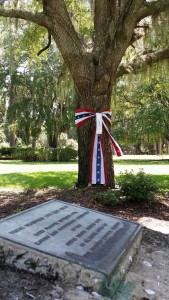The Jekyll Island Authority is the steward of the cultural resources on Jekyll Island. Historic sites, objects, landscapes, and structures are all chapters of Jekyll Island’s story and provide a record of past human activity.
Many cultural resources that are valuable to understanding the island’s past can be found in unexpected locations.
The Avenue of Palms
Jekyll Island’s Avenue of Palms consists of nearly 300 cabbage palms, planted in intervals along Plantation Road, from the north end of Stable Road to Faith Chapel. Many of these palms were originally planted around 1890, but others were lost to storms, pests, and disease. These were recently replaced in order to restore this palm avenue.
If you look closely, you can find “ghosts in the trees,” the remains of nail holes, in some of the original palms. During the Jekyll Island Club Era, nails were used to train the Cherokee rose, the state flower of Georgia, to run up the tree trunks, and Cherokee rose garlands and swags ran from tree to tree.
Bicentennial Oaks
In honor of the thirteen original colonies, thirteen oak trees were planted during the October 1976 bicentennial celebration by the Jekyll Island Garden Club. Today this site is a favorite scenic stop near Villa Ospo, overlooking the Jekyll River.
Brick Outlines
As you walk about the Historic District, you may discover brick outlines set into the pavement. These bricks mark the locations of historic buildings that no longer exist. Two examples can be found in the large parking lot behind the Jekyll Island Club Resort. Look for the signage nearby that explains the hidden story behind these mysterious markings.
Green Posts
The green posts that you see scattered about the lawn of the Jekyll Island Club National Historic Landmark District mark the locations of historic cottages that no longer exist. Interpretive panels are located near some of these posts, so that you can learn more about the unseen past.
Bricks from Pulitzer Cottage
Joseph Pulitzer’s home was subject to a fire in the 1950s that resulted in more fire damage than could be repaired. In an interesting form of recycling for the time, the Jekyll Island Club salvaged the bricks from Pulitzer Cottage to build the original golf clubhouse at Great Dunes as well as some of the bathhouses on the Oleander Golf Course.
Crane Bicycle Path
The Crane bicycle path stands as a reminder of one of the Jekyll Island Club Member’s favorite pastimes – bicycling around the island. The Crane bike path is one of many historic pathways that crossed the island and were privately funded by individual Club Members. Charles Lanier, President of the Jekyll Island Club, wrote: “Too much cannot be said of the attractiveness and beauty of the thirty miles of drives, also of the bridle and bicycle paths, through the pine and live oak forests and the palmetto, holly and magnolia, thence out on the magnificent beach.”
Great Dunes Golf Course
Walter J. Travis designed the seaside course during the Roaring Twenties for the exclusive Jekyll Island Club. The first three-time winner in U.S. Amateur Championship history, Travis was also the first non-British citizen to win the British Amateur Championship.
In 1926, Travis was hired to build Jekyll Island’s Great Dunes Golf Course. He redesigned existing holes and added new ones along the beachfront. Travis declared he “was enthusiastic over the prospects at [Jekyll] for one of the most beautiful courses in the country.” Travis passed away on July 31, 1927. He never saw the course completed. The Great Dunes Golf Course opened in January of 1928. Today, the remaining nine holes of the Great Dunes Golf Course are an authentic example of Travis’ legacy. In all, he designed or remodeled approximately 50 golf courses.
Old Plantation Road
Old Plantation Road is one of the oldest roads on the island. It dates back to the 1800s. It was named such because it leads directly to the “Old Plantation,” now the Horton House Historic Site. This road cuts through the Jekyll Island Club National Historic Landmark District and also passes through some of the residential communities here on the island.
Plantation Oak
The largest live oak in the historic district is nicknamed Plantation Oak and is estimated to be approximately 375 years in age. Recognized by the Live Oak Society of America, it is perhaps the best overall live oak specimen on Jekyll Island. It best exemplifies how live oaks can become much broader than they are tall as they mature over time. As the largest branches extend further out from the main trunk of the tree, the weight of each branch actually causes them to rest on the ground, providing the tree with greater stability.
Shell Road
Shell Road, like many of the other main roads here on Jekyll Island, dates back to the time of the Jekyll Island Club. Shell Road was the most common route taken by Club Members and guests alike to gain access to the beach.


